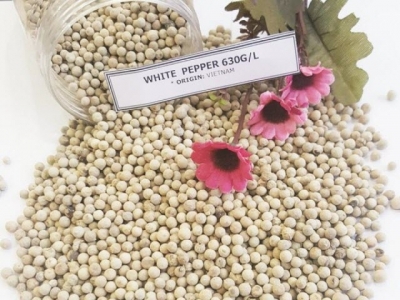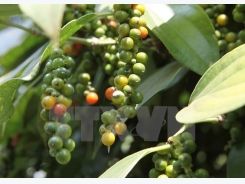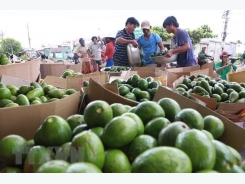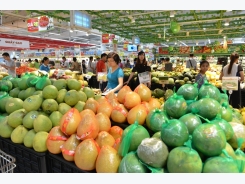Value adding problem for pepper

Facing the inadequacies due to the recent fast area increase, the pepper industry has made certain changes in production and processing. However, in order to develop sustainably, more effort is needed from the government and enterprises to increase the value of pepper products in Vietnam.
Vietnamese pepper is inferior to many countries in terms of product diversification. Picture: ST.
Le Van Duc, Deputy Director General of the Cultivation Department under the Ministry of Agriculture and Rural Development said that in the coming time, pepper industry will focus on exploiting the traditional markets of Western Europe , East Asia and North America. Accordingly, mainly exporting high quality pepper (clean pepper, sterilized, ASTA, ESA, JSA), the processed products must have the Vietnamese brand name andgeographical indicationsof origin. For countries in Western Asia, the Middle East and Africa, the focusis primarily exports ofblack pepper (FAQ)with average standards.At the same time, in future, this standard must move forward to higher quality (ASTA standard) according to the general world trend.
Mr. Duc noted that the pepper industry also needs to step by step penetrate the final consumption market in consuming countries where there is ahigh quality pepper market (grinding pepper, bottle pepper, peppers of spice) which are directly sold to major spice distributors with supermarket chains, and especially Asian spices directly sold to food processors in consuming countries. In order to penetrate this market, it is required that pepper processing and exporting enterprises have a well-established processing plant, branding for their own pepper factories,and demonstrating the ability to supply them regularly and long term.
According to the statistics of the Pepper Association, by 2017, the pepper industry in Vietnam has 20 processing plants, including 5 factories of FDI enterprises. The factories have modern technology to ensure the processing of pepper quality to global standards. For most markets, the Vietnamese pepper industry has been able to meet all the quality requirements of our customers, such as clean ETO, clean FAQ 400/450/480/500/550 / 600g / l. , clean pepper standard ASTA (for US market), disinfection sterilization (HTST) ... Many pepper processingfactories in the world have invested in modern processing equipment to obtain the highest certification for pepper, meeting the requirements of fastidious markets such as BRC-Food, HACCAP, GMP, LEED certification; ISO 22000; ISO 9001: 2008; SAN (RA) ....
Recently, the value of white pepper has increased, many enterprises also promote the processing of white pepper. Especially, some large scalewhite pepper processing factories have been equippedwith high technology, processing products through steam, sterilization, vacuum bagging, ensuring food hygiene and safety. In addition, pepper powder and soaked pepper in salt water are also being marketed by foreign markets. Typically, KSS Viet Nam Co., Ltd. has provided more than 30 types of pepper for Japan and other countries.
In addition, according to Nguyen Nam Hai, Chairman of the Vietnam Pepper Association, compared to 2-3 years ago, the situation of using pesticides on pepperthis year hasbeensignificantly improved by farmers who are better aware of the importance of quality. Many farmers worry that pepper will be used with more pesticides, which will make it more difficult to consume. At the same time, there has been a shift in the state management of pesticide production and distribution systems recently. Many enterprises and international organizations support the production of clean pepper. It is being developed strongly in pepper growing areas.
Typically, Binh Phuoc is implementing the project of sustainable supply chain development. After 5 years of implementation, there have been 24 sustainable pepper clubs with 510 farmers participating on the area of 688 hectares with certification of Rainforest, wherethe yield reached nearly 1600 tons,with a purchase higher price than the average market price from 3,000 to 5,000 VND / kg. In the last months of 2017, the project continued to mobilize the establishment of 36 new clubs, bringing the total number of clubs to 60 clubs with 1,547 pepper households, thereby helping to expand the scale and raising thehigh efficiency project. In other provinces such as Dong Nai, Ba Ria - Vung Tau, Dak Nong, Gia Lai ... have formed cooperatives producing clean pepper, organic pepper ...
However, according to experts, compared to some other pepper producing and processing countries, Vietnamese pepper is inferior in the level of product diversification due toanimmature Vietnamese pepper industry. Vietnamese pepper has not built abrand name yet, the Vietnamese image has not invested in researchand development, and marketed by investors and processors. The strategy of the pepper industry in Vietnam has not clearly shaped the main products, so pepper is mainly exported under the raw products with traditional products such as black pepper, white pepper and some crushed pepper products, which leads to the market share to be quite small.
Accordingly, it is necessary to develop a strategy to diversify pepper products, to promote the development of the pepper processing industry together with policies to encourage enterprises to invest in research and development for this field to add value.
Mr. Le Van Duc, Deputy Director of Department of Crop Production, Ministry of Agriculture and Rural Development:
In fact, the area for pepper productionin the world in recent years has increased, especially in some countries like Brazil and Cambodia. The advantage of Vietnam's pepper productivity is 2.5 times higher than world average productivity and with improved processing technology, Vietnam can dominate and regulate the world pepper market. On the other hand, the reduction of area in comparison with the current one will be less feasible, affecting the production, life and employment of producers. Therefore, Vietnam should maintain a stable area for pepperofabout 100,000 - 120,000 ha, the area for product is 95,000 ha, average productivity of 25-27 quintals / ha, output of about 237-256 thousand tons. By 2030, the area forpepper productionwill be kept at 100,000 ha, the product area will be 90,000 ha, the average productivity will be 27 quintals / ha and the output will be around 243 thousand tons.
Mr. Phan Minh Thong, General Director of Phuc Sinh JSC joint stock company:
Since 2012, Phuc Sinh has been cooperating with many farmers in Buon Me Thuot, implementing the pepper projects with the standard of ‘The Rainforest and achieving this certification in 2014. Thanks to that, each year, the company exported 20.000-25,000 tones of pepper, of which 40% were exported to the EU with high requirements on food safety for imported pepper.
Ms. Le Thi Anh Tuyet, Deputy Director of Binh Phuoc Department of Agriculture and Rural Development:
Previously, only about 50% of Binh Phuoc pepper reached food safety standards for export to the EU. However, after the Nedspice company and Binh Phuoc Agricultural Extension Center cooperated with farmers to implement the project on sustainable development of 1,000 hectares of pepper, the amount of pepper harvested in this area, through inspection, reached 82% Export standard to EU.
N.H
Có thể bạn quan tâm
Phần mềm

Phối trộn thức ăn chăn nuôi

Pha dung dịch thủy canh

Định mức cho tôm ăn

Phối trộn phân bón NPK

Xác định tỷ lệ tôm sống

Chuyển đổi đơn vị phân bón

Xác định công suất sục khí

Chuyển đổi đơn vị tôm

Tính diện tích nhà kính

Tính thể tích ao hồ



 Fruit & vegetable trade up in January
Fruit & vegetable trade up in January  Fruit and vegetable exports yield sweet results
Fruit and vegetable exports yield sweet results